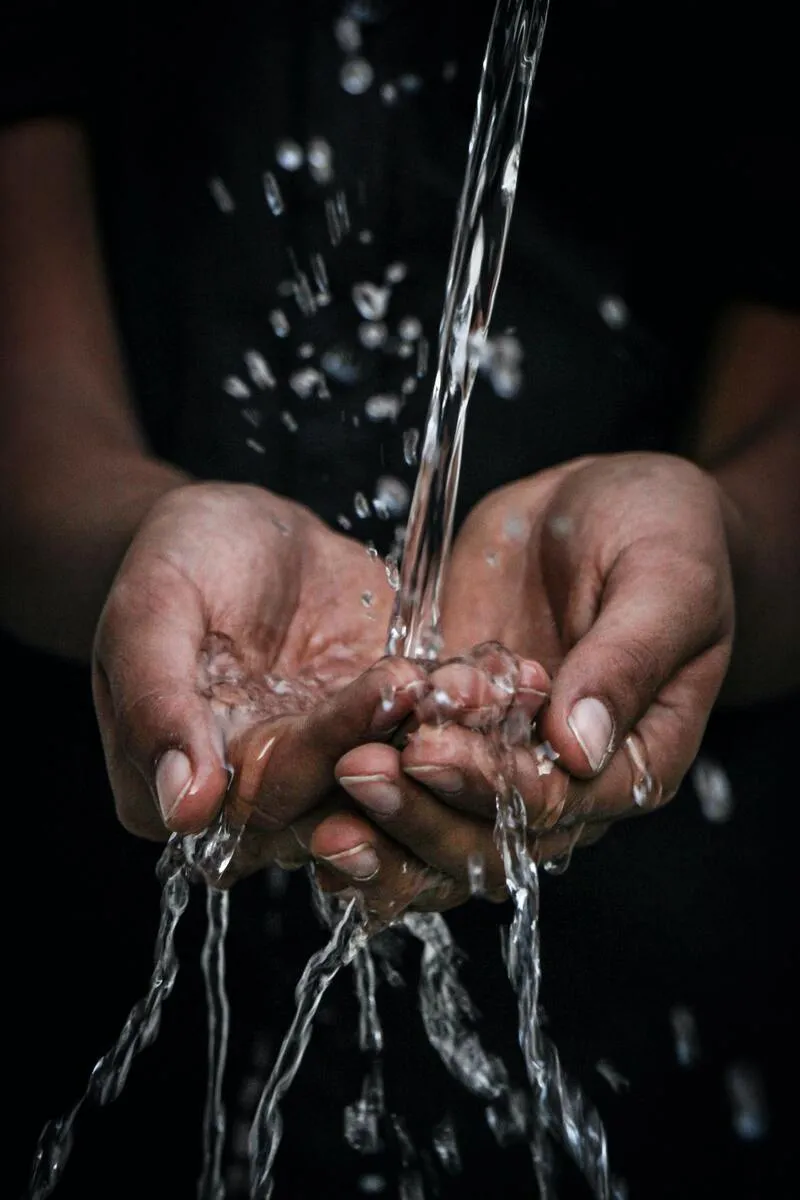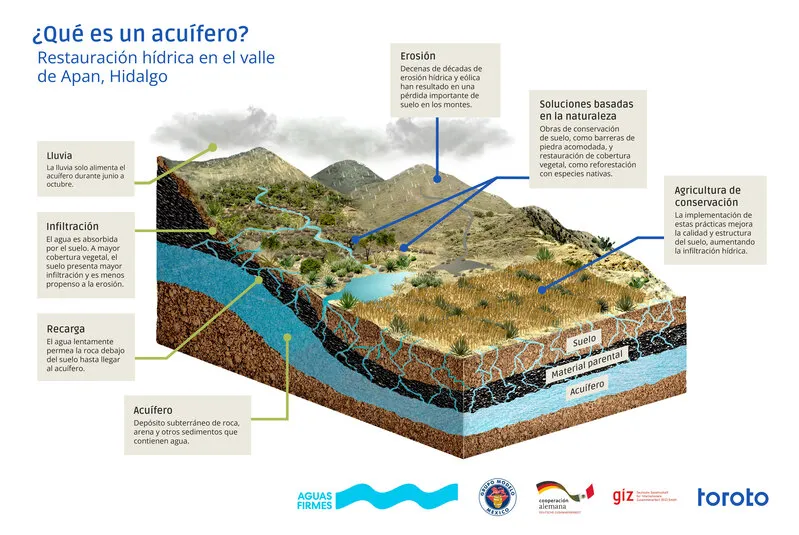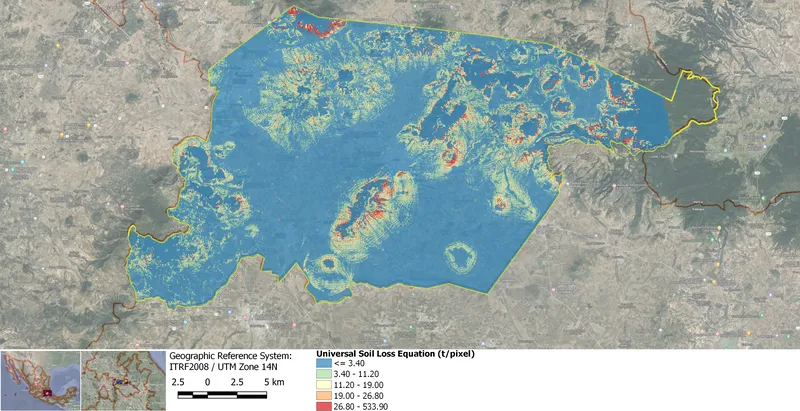Planet Earth or planet water?



Planeta Agua
It is curious that we call our planet “Earth” when it is mostly covered with water. All life as we know it revolves around this liquid and yet, as a resource, it is seriously affected.
The main reasons why water in general is in danger are due to its pollution and scarcity. On the one hand, pollution can be caused by the excessive use of pesticides, wastewater discharges, high concentrations of microplastics, oil spills or other fuels, acidification due to the increase of carbon dioxide in the atmosphere, eutrophication and so on. On the other hand, physical scarcity of water, also known as water stress, occurs mostly when a body of water - either superficial, or more commonly, an underground one - is overexploited in such a way that the time it takes to recharge or recover it is not balanced with the amount of water extracted, and therefore, there are geographical areas of the planet that no longer perceive this resource; Mexico, for example, is in an imminent water crisis.
More generally, today, water stress is a consequence of climate change by causing the retreat of glaciers (and their subsequent contamination with salt water), as well as the evaporation of surface water.
To put the seriousness of the above into context, we must mention that terrestrial water is distributed in salt water (97%) and fresh water (3%), with fresh water being almost all of the water we consume and occupy. Of this percentage of fresh water, the majority is in a solid state, forming polar ice caps and glaciers (69%), while the rest is in liquid form, as surface water (0.5%), forming rivers and lakes, and the rest (30%) is as groundwater (WWAP, 2009). Remember that all values are approximations.
Groundwater can be consolidated in a variety of ways underground, ranging from occupying the available spaces in the pores of rocks, to being found in larger and larger formations known as aquifers. Aquifers are the most important and immediately available source of fresh water for humanity, since it is estimated that 70% of the water we occupy comes from an aquifer. More importantly, around 40% of that same water is used directly for agriculture and irrigation (Ibid.). These freshwater supplies are not only essential to human existence, but they also play an indispensable role for ecosystems. Groundwater nourishes the world's arid and semiarid areas, where precipitation fails to meet the needs of vegetation and organisms dependent on it. It also keeps the level of surface water bodies stable, as well as providing them with a constant flow that allows the distribution of nutrients and prevents them from stagnating. On the other hand, groundwater is an essential link in the water cycle, even if it doesn't seem so because of its “invisible” condition for human sight.
The main problem that puts our largest supply of fresh water at risk is pollution. The contamination of a groundwater body can become chaotic due to the distance it travels underground, and to the permeability of the rocks with which the water interacts to move. In this way, an agricultural field that is highly inoculated with pesticides can contaminate the entire aquifer because rain encourages the infiltration of water from the surface (contaminated) to the subsoil (clean). This example is unfortunately more common than we imagine, and it happens with any pollutant found on Earth and is soluble in water and permeable to rocks. The second problem, and which we will explore later with a case study -and a hopeful example-, is overexploitation. Overexploitation of an aquifer occurs when we remove a larger volume of water than is naturally refilled or infiltrated.
To deepen our understanding of the above, we can see Figure 1, which illustrates a fraction of the water cycle by making visible the management and conservation actions of the Apan aquifer, Hidalgo. When rain falls on the ground, it usually infiltrates (there are situations that prevent infiltration, such as water erosion -which we will see later-, soil compaction and salinization, among others). Once the water is absorbed by the soil, it slowly permeates through the parent rock and is eventually deposited in the aquifer. Infiltration is a relatively fast process; aquifer recharge, on the other hand, is a slow process that involves accumulating the infiltrated water until a certain volume is obtained.

Figure 1. Water restoration in Apan, Hidalgo
Image created by Sofía Aguilar for Toroto as part of the Aguas Firmes program.
Water as a resource faces very adverse situations, most of them anthropogenic in nature, however, efforts to protect it are many and widespread. We celebrate World Water Day because water is life. Water is everyone's food; the engine of the immense vegetation it inhabits; home to the vast majority of organisms that reside on Earth; an indispensable resource for carrying out -in some way or another- all the productive activities we carry out. Water is our right and for this reason, since 1992 and within the framework of the United Nations Conference on Environment and Development held in Rio de Janeiro, March 22 has been declared World Water Day.
Taking care of water, we protect the soil: management and conservation activities of the Apan aquifer, Hidalgo
Alejandro León Aguilar
After careful and thorough planning, during 2020 and 2021, Toroto -as implementing partner of the program Firme Waters, operated and financed by Grupo Modelo and the German Cooperation for Sustainable Development (GIZ) GmbH- intervened several hundred hectares of land in Apan, Hidalgo, with the intention of increasing water infiltration into the important aquifer that houses this valley.
Aquifer management and conservation activities, whose main objective is to promote water infiltration, were carried out over the last two years and have focused on the following: the reforestation of more than 235 ha in order to recover ecosystem functions; the establishment of more than 45 km of living barriers with plants native to the region, such as species of the genera Agave, Opuntia, Pinus and Quercus; the construction of more than 10 km of surrounding stone barriers and 12 gabion dams; the removal of three main bodies of water: La Laguna, Los Llorones and La Vega, where in total more than 12,000 m3 of sediment were removed. In addition, Toroto, in collaboration with Grupo Modelo, has given several workshops to landowners to share best agricultural practices, as well as other useful information on sustainability and conservation; in this way, we seek to create close links that allow long-term management. All these activities aim to inject an additional 1.8 hm3 - that is, 1.8 billion liters - of water into the aquifer, which would help it maintain a healthy balance: when we have healthy aquifers, the amount of water we extract from them is proportional to the amount of water that is infiltrated, so that they are never overexploited. However, promoting infiltration is not an easy task, but it brings great benefits.
As is recurrent with interventions such as the one mentioned above, impacts and benefits are usually not one-dimensional. So, What other benefits do these nature conservation activities bring to the environment?
One of these is the prevention of soil erosion. Water erosion occurs when the force of rain and the energy of the subsequent runoff flow tear the topsoil. The particles generated from this friction are then carried by the current to other locations, which can affect channels, bodies of water and human infrastructure. This type of erosion affects Mexico the most, and it is also the most common in Apan, as it is easily exacerbated by human activities. Water erosion has serious consequences within ecosystem dynamics, but above all, it affects nearby populations. When soil erodes, it loses the surface layer where much of the organic matter and microorganisms that give it fertility are found, so it becomes an almost inert substrate, which is very poorly functional for agriculture, among other activities. On the other hand, this soil that erodes becomes sediment that, due to the action of air and water, ends up accumulating somewhere else, generating - in the worst case scenario - floods and azolves.
Another consequence has to do with aquifers. Because water erosion occurs between water and the top layer of the substrate, the latter prevents water from infiltrating and, therefore, recharging the aquifer. On the other hand, when the amount of water that goes to the lower layers of the soil increases, such as the subsoil and the parent rock, the water becomes Infiltrate, so the amount of water that drains decreases, causing erosion to also decrease. Consequently, activities to promote water infiltration (as are all the actions carried out for aquifer management mentioned above) have a direct impact on the amount of sediment that is generated, since by promoting infiltration, erosion is prevented. This is how we ensure that less soil suffers from water erosion.
How closely related are these two previous processes? To estimate the impact of water infiltration activities on soil erosion, we first evaluated the current state of the “soil” resource in the valley. The Secretariat of Environment and Natural Resources (SEMARNAT) (2013) and Bolaños et al. (2016) have published soil erosion reports at the national level. In these documents, erosion in Apan is considered to be between moderate and extreme. In addition, Bolaños et al. (2016) report that at least 70% of the Hidalgo landscape is affected by water erosion, while SEMARNAT (2013) states that erosion generates 10 to 200 t/ha/year of sediment depending on the severity of the degradation.
To corroborate the information that SEMARNAT (2013) and Bolaños et al. (2016) published on soil erosion, Toroto supported -in addition to Grupo Modelo projects- by preparing an evaluation of this resource. Using data from government sources, collecting field data and using specialized software, we were able to determine that an average of 152 t/ha/year of sediment is produced in Apan, which is in line with the values mentioned above, as reported by SEMARNAT (2013). In addition, we generated a map showing the specific areas where soil is lost, as can be seen in Figure 2. The areas most impacted by erosion are the hills northwest of the city of Apan and the elevations that separate the municipalities of Apan and Tepeapulco, as well as the hills directly south of the city of Apan.

Figure 2. Soil erosion map
Source: author's creation
Once we perform the initial assessment of the soil in the valley, we consider the effect of water infiltration activities. The region where the water infiltration activities were carried out is concentrated on the slopes between the boundaries of Apan and Tepeapulco, and this is where the mitigation effect is mainly found, that is, the reduction of soil erosion. This mitigation effect has a direct impact on the sediments that end up in the cities and towns of Apan, Los Chiteros, Lomas de Pedregal, San Lucas, Los Reyes and La Laguna. The results of the analysis show that in this region alone there is a decrease of 79,000 tons of sediment per year, which represents approximately 5% of total erosion for each location mentioned above. Throughout the valley, soil erosion decreases by 1%, from 152 t/ha/year to 151 t/ha/year (despite the fact that the total area intervened is less than 0.4% of the surface of the valley), which means a total of 87,500 t/year of soil that is prevented from eroding.
What should we conclude from this? There is irrefutable evidence that water infiltration activities also protect the valley against soil erosion. Even though the intervened area is only a small fraction of the entire valley (approximately 0.4%), there are great benefits in terms of soil protection and water generation for the entire basin, since as we saw earlier, the more we avoid water erosion, the greater the infiltration of water into the aquifer, the more water will be available and the healthier the surrounding ecosystem will be.
Water is life
As we were able to observe through the case study, water protection and management activities bring complementary advantages for both the population and the ecosystem - and reducing soil water erosion is just one of them. This allows us to glimpse the great interconnection that exists between the management of natural resources and environmental dynamics. They show us the vast potential of nature conservation activities, as well as the additionality they bring. Just as ecosystems are complex networks of interactions between organisms and abiotic entities, their management also generates complex networks of mutual benefits.
Water is a resource that we all depend on; a resource that also allows the support and regulation of other basic resources for life, such as forests, food, climate, air quality, soil and others. Because of what it is in us, its main degraders, to manage it sustainably to ensure a future of water security (UNEP, 2005).
Therefore, we want to recognize the valuable work of the program Firme Waters, operated and funded by Grupo Modelo and the German Cooperation for Sustainable Development (GIZ) GmbH, as well as our team in Toroto and the community in Apan for working and managing our right to water.
Water is life. Let's protect her.
References
Explore reflections, research and field learning from our work in ecosystem restoration.